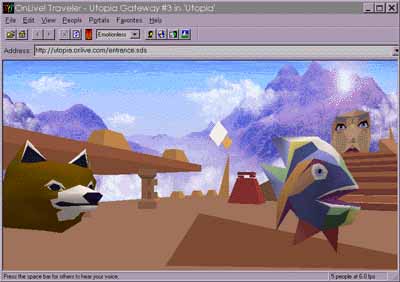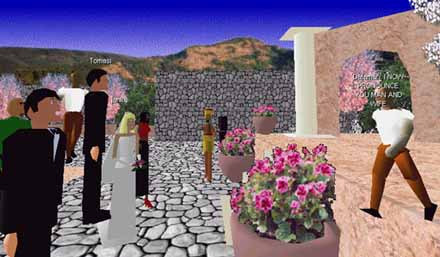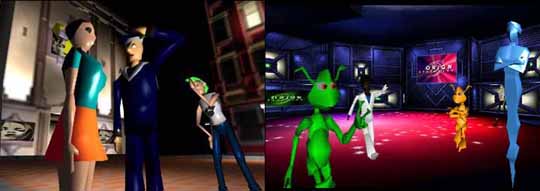
Putting a Human Face on Cyberspace:
Designing
Avatars and the Virtual Worlds They Live In
To be held at SIGGRAPH
97, Los Angeles Convention Center
Thursday,
August 7, 1997 from 4 p.m to 5:45 p.m.
Followed by
a Birds of a Feather
Join
our Online Discussion Now!

User
avatars in conversation in the voice supported Onlive Traveler
virtual world, August 1996
The Emergence of a New Design Medium
Who do you want to be today? As thousands of Internet users begin
new lives as 'avatars' in virtual worlds, a new design industry
is being born. SIGGRAPH 1996 had several panels, BOFs, exhibits,
and discussions on VRML, character animation and multi user virtual
communities. These forums introduced the medium we term avatar
cyberspace to the SIGGRAPH community. Since SIGGRAPH,
conferences such as Virtual Humans, Earth to Avatars 96, World
Movers, and VRML 97 began to flesh out some of the major issues
in designing for avatar worlds. In addition, avatar standards
efforts such as Living Worlds, Universal Avatars and Open Community
have been initiated.
Avatars and the worlds they live in comprise a vast new design
medium attracting a wide range of professionals including: anthropologists,
3D and multimedia designers, character animators, musicians, voice
and facial expression specialists, performance artists, architects,
business workgroup and workflow experts, and educators involved
in distance learning.
The Discussants
We have assembled a group of experts to discuss the technologies
underlying avatars, design tools and approaches to build avatars
and the worlds they live in, and the psychological relationship
of users to their avatars.
Bruce Damer: Bruce Damer is co-director of the Contact
Consortium, the world's leading forum on avatar virtual worlds.
Bruce speaks and writes extensively on new Internet frontiers
and is completing a book on avatar worlds.
Steve DiPaola: Steve DiPaola
leads a team of artists, architects, UI designers and musicians
in designing and developing 3D Avatars and virtual spaces at Onlive!
Technologies the creators of the Traveler voice-supported virtual
world.
Moses Ma: Moses Ma is an Internet and computer gaming visionary
and was the originator of the Universal Avatars specification
with IBM. He recently became co-author of the Open Community VRML
multi-user specification proposal with Mitsubishi Electronics.
Ioannis Paniaras: Ioannis Paniaras is completing graduate
research at the Media Lab of the University of Art and Design
Helsinki UIAH. Ioannis is studying virtual communities and avatar
fashion trends and their influence on social life in Cyberspace.
Kirk Parsons: Kirk Parsons is a developer of avatar authoring
software and has served as a chief avatar technologist for a number
of companies including Black Sun Interactive.
Bernie Roehl: Bernie Roehl is a software developer based
at the University of Waterloo in Ontario, Canada. Bernie has written
several books and dozens of articles on virtual worlds and currently
chairs the Virtual Humans Architecture Group.
Issue Areas

Avatar
wedding in AlphaWorld, May 8, 1996
The design of multi-user graphical virtual environments is one
of the most challenging new areas in computer science and consumer
on-line services. Supporting tens of thousands of users in simultaneous
communication in a shared virtual environment, within which they
can build their own spaces and shape their own faces might seem
like an impossible task. Yet, a dozen such environments are running
today, hosting over 350,000 users dialing in from home PCs.
The number one question asked by users entering these virtual
environments is: how can I design my own avatar
(their virtual embodiment)? The success or failure of these environments
in research or commercial settings can hinge on avatar design
issues. Basic design decisions often involve trade-offs: in the
basic technology choices (2D versus 3D, polygonal versus photorealistic),
in the methods of communication (text versus voice, gesture versus
facial animation) and in the use of standards (VRML versus proprietary
3D, IRC versus custom communication backbones). The most difficult
design criteria to pin down are aesthetic: what makes one person
'like' or 'identify' with their avatar can be often very personal
and subjective.
The panelists will focus on design approaches for avatars within
the emergent 'avatar cyberspace'. Some panelists will give an
overview of the underlying technologies of avatars, some will
describe their experiences designing and using avatar virtual
worlds and others will address aesthetic and psychological issues
surrounding avatars.
We encourage you to download and try some of these virtual worlds.
There is a comprehensive gateway to the medium of Avatar Cyberspace
at http://www.digitalspace.com/avatars.
Additional information on projects and debates within Avatar Cyberspace
can be found at the Contact Consortium home page at: http://www.ccon.org.
Summaries of the Individual Presenters
Bruce Damer, Panel Moderator
What the moderator will contribute to the panel
In my task as moderator, I will guide the panelists through the
major themes and provide a continuity to the work done over the
past year, making sense of the trends and technologies for the
audience. I also plan to act to discipline panelists to stay focused
on the issues of avatar design (as this topic area is so broadly
connected to other interesting subjects).
The moderator's viewpoint on the panel topic
I feel that the panel topic will emerge into a whole discipline
of design, emerging from the synthesis of many different fields.
To take a cue from Nicholas Negroponte, the question we face is
no longer: are you being digital? but is now
what is your digital being?.

Avatars
meeting in street scenes in OZ Virtual, March 1997
The Panelists
Steve DiPaola
What Steve will contribute to the panel
I will speak about design approaches which rely heavily on techniques
to make users feel that they are really interacting in the
virtual space: 3D attenuated voice and sound, 3D navigation,
an immersive first person U.I., individualized 3D head avatars
with emotions and lip sync, 3D space design. I will then cover
how well Onlive has transposed this experience to consumer based
PC platforms connected to the Internet at dial-up speeds. During
the panel, I will connect live to a virtual world allowing panelists
to query users and ask for themselves how effective the design
approaches are.
The panelist's viewpoint on the panel topic
The design approach to avatar cyberspace that I bring is born
of experience trying to emulate natural social paradigms and provide
immersion in a 3D visual and sound landscapes. Three more-detailed
examples of design choices we have made might spark interest and
debate within the panel and the audience:
- Does community come from communication? I hold that
the structural process of a community and socialization, real
or virtual is communication and that the most natural human form
of communication is verbal. Therefore, 3D spatial multi-participant
voice with distance attenuation, and stereo positioning is the
best tool for the development of virtual cocktail parties and
virtual communities alike. Other panelists or the audience may
choose to challenge this view based on their experience in text-based
virtual community.
- You are your avatar, but can we use just heads? A fundamental
goal of avatar cyberspace is to bind the Real Person at their
computer ~with~ the Virtual Avatar in cyberspace. Given the finite
CPU/polygon/bandwidth resources, we need to invest in the most
natural form of socialization first: face to face. I posit that
the body (hand gestures, body language) is secondary for human
communication and can be added later. Would anyone care to challenge
this?
- Major Design Issue: physically based spiral of infinite
betterment Given the natural emulation goal, one might assume
that the design choice is to strive to make things more and more
realistic, this is not so. A major truth in computer graphics
and simulation (and well known for facial modeling) is the more
realistic you make something, the more open to criticism it is
for not being realistic enough. So we emulate natural paradigms
just enough to achieve recognition of familiarness. Is 'just good
enough for all practical purposes' just good enough?
Moses Ma
What Moses will contribute to the panel
I will contribute my background and experience in attempting to
develop and promote a standard set of formats, protocols and design
methodologies for avatars. Until now, avatars have been system
and browser dependent, which meant that an avatar created for
one virtual world wasn't necessarily compatible with other worlds.
A number of people in the VRML business have put together a proposal,
called Universal Avatars, which details a way to standardize what
avatars are and do.
By using this proposed standard, avatars will be able to move
from one world to another, keeping the same appearance and behavior.
This means that users will be able to recognize other users' avatars
that they met in other worlds. And their avatars will have individualized
automatic actions, moods, and even pets. And they'll be able to
tell how their friends, from around the world, are feeling today,
just by the look on their avatar's faces.
The latest draft of our proposal now deals with a variety of issues,
which begin with 3D models and behaviors, but now ventures forth
to discuss other important issues, such as persistent identity,
interworld communications, database concerns, and support for
additional emerging standards such T-120, H-323 and Versit. We
believe that this is an early basis for an emerging operating
system for socialization.
The panelist's viewpoint on the panel topic
Clearly, it would be useful to have a standardized avatar representation
for the purpose of visiting all virtual worlds with a user's preferred
avatar representation and openly tendered identity profile. This
has many benefits, including the reduction of the workload on
the user, the standardization of global search for other people
through their public avatar presentation, and the ability to create
new business opportunities for VR vendors. The Universal Avatar
system, if adopted, could have a fundamental impact on the design
of avatars in the medium of virtual worlds on the Internet.

Various
avatars designed by Ioannis Paniaras
Ioannis Paniaras
What Ioannis will contribute to the panel
As an artist, designer, and researcher in CMC (computer mediated
communication) I will focus on issues related with the aesthetics,
the design, the visual management of the avatar, its identity
and the community of avatars and their cultural manifestations
through a design perspective. I will pose the following provocative
questions to the panel:
- What is a virtual persona and how does one design for and
manage a virtual persona?
- How do the aesthetics and the visual appearance of an avatar
can contribute to a didactic state of virtual life and communication
in the virtual community?
- How does the design of the avatar influences the identity
and the perception of the self in real life?
- What is an ideal interface for human contact?
I will also demonstrate some design examples of avatars with articulation
and expressions.
The panelist's viewpoint on the panel topic
This medium is not understood well but has demonstrated the power
to defragment the solid identity [the modern notion of the identity]
and sustain the emergence of a plethora of virtual identities.
Avatars are part of the visual and behavioral grammar of the emerging
cultures in virtual communities, and by analyzing the design structure
of the avatar we help understand the direction we might heading
in human contact. I would like to ask the audience think about
new visions for avatar mediated communication which originate
in knowledge of human behavior.
Kirk Parsons
What Kirk will contribute to the panel
I will focus on avatar representation issues, including avatar
animation. My presentation will be done from a technical perspective,
with the goal being to relate the key technical trade-offs to
avatar authoring possibilities. This presentation will be complementary
with Ioannis' in that he will be focusing on top level artistic
issues, while I'll focus on how the underlying technology affects
an artist's choices in the design process.
- Expressiveness in avatars - how is it achieved
- Suspension of Disbelief
- Morph based animations
- Keyframe animations
- Real-time motion technologies
- Artificial Intelligence and Avatars
The panelist's viewpoint on the panel topic
I believe that any designer of avatars must have a solid understanding
of underlying technologies, not only to enable them to function
within narrow bandwidth constraints, but also to create effective
and aesthetically pleasing designs. The use of photorealism to
reduce polygon count, texture mapping and morphing to create facial
expression and other 'tricks' must be in the designer's grab bag
of techniques.
Bernie Roehl
What Bernie will contribute to the panel
What I will contribute to the panel is a strong background in
the technology of virtual reality, as well as insight into the
activities of various groups (Living Worlds and the Virtual Humans
Architecture Group) which are relevant to our efforts at avatar
standards definition and avatar design. I feel it's important
that we acknowledge the need to create expressive and communicative
avatars within the constraints imposed by bandwidth, latency and
rendering performance.
The panelist's viewpoint on the panel topic
My viewpoint on the panel is that it should attempt to identify
and prioritize the most important issues related to avatars, as
a first step towards dealing with those issues. My own personal
feeling is that the key issues are:
- defining standards that enable the creation of interoperable
avatars
- creating tools that allow users to create their own avatars
- provide avatars with as much expressive power as possible,
using voice and gesture and facial expressions
- find effective methods for integrating speech, expression
and movement
- issues surrounding identity and the ownership of one's virtual
self
Return
to the Panel Threads